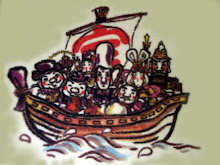In accordance with the opening of Kobe trade port the land for foreign settlement was designed by an English civil engineer, J.W.Hard following the modern city planning. The land separated into 126 divisions by grid roads so orderly and infrastructure such as roadside trees, parks, street lights and sewers were well arranged, and the appearance is now remained.
The English paper "The Far East" at that time told it as the best designed beautiful town for the foreign settlements in the Far East. Especially building #5 remains the shape of the foreign dealer's factory at Meiji period. Although it had been designated as an important cultural property, as a matter for regret, it was lost and rebuilt due to 1995 Earthquake.
The land space is 547 yard square area formed by Eastern Ikuta River to Western Koikawa street and Northern Old Saigoku Road to Southern coast line. Excellent Self-Government Organization called "Settlement Conference" well controlled this isolated place voluntarily. They had a Police group to crack down and the caught criminal was handed to an each council as a matter of fact. The success of all controlling dues to the least population there at that time.
According to the Anglo-Japanese treaty of commerce, Foreign Settlement place was returned to Japan at 10 AM, 17th, September, 1899, every foreign country returned all the interests and assets to Japanese Government. After that the control of the place was relegated to Kobe Prefectural Authority and Japanese new names were applied such as Kaigan-dori and Harima-machi.
After the return of the Foreign Settlement, many a Japanese merchants went back and forth there and the place made remarkable development, especially because of the break out of the WW-Ⅰin 1914, global need for ship transportation made Port Town Kobe extraordinarily busy and also boiled up by shipbuilding rush.
Kanto big Earthquake happened in 1923 destroyed Yokohama port and the import and export products there were brought to Kobe. So, Kobe port town kept more progress day by day, but the Foreign Settlement itself shrunk it's business amount instead the damage by the WW-Ⅰ. Domestic shipping company, trading company and bank advanced there while that period of time. Modern Western style office buildings were constructed on the place one after another.
Immediately after the breaking out of the WW-Ⅱ, the activity of the foreigners in the Settlement far set back and most of them obliged to come back to their home countries regardless of their choice. On the 5th, June 1945, Kobe was attacked by US Bombing Air Force with the Boeing B-29 Bombers Superfortless and almost of the function of Kobe were destroyed exaggeratedly, 70 % of the Foreign Settlement with 126 sections were also done at that moment.
Social atmospheric condition didn't permit the reconstruction soon after the War, but the later War affair in Korea in 1950 helped Kobe to survive unintentionally. Coming into High growth period in 1960, Kobe became prosperous but the tendency to move the main office building to Tokyo was the worse factor for Kobe and the economy fell down again.
In 1983, the Forme Foreign Settlement was specified as "Urban Landscape Formation Area" in Kobe City Landscape Ordinance. The operating organization of the place was reinforced more by changing the name from the Settlement Liaison Council to the International District Mutual Society.
Repeatedly, a truly devastating Earthquake struck Kobe in the 17th, January 1995, 106 buildings at the Settlement were destroyed and 22 of them were forced to remove with no hope. The most regrettable ones historically worth keeping were removed with tear drops. 8 years later from the Earthquake, almost of the constructions were restored with the most sophisticated technology such as Seismic isolation structure.
Keeping the old atmosphere of fascinating Kobe, all of the functional performance of Kobe Port Town was reconstructed with the most sophisticated ideas and technology and the former bustle was acquired as a matter of fact.

















































